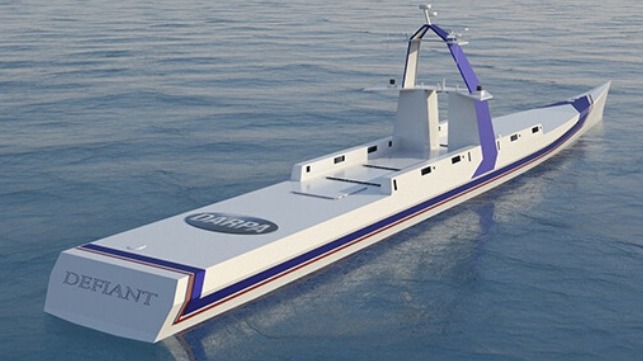DARPA Moves Forward to Build and Demonstrate Medium Unmanned Ship

DARPA, the U.S. Military’s agency focused on developing breakthrough technologies for national security, is moving forward with its program to build, test, and demonstrate its first unmanned surface vessel. In phase two of the No Manning Required Ship (NOMARS) program, DARPA has commissioned the development of a medium-size vessel that can perform missions with reliability and availability, while carrying a significant payload.
Known as Defiant, the design calls for a first-of-its-kind vessel. The 210-metric ton MUSV-class ship (medium unmanned surface vessel) aims to maximize performance, reliability, and maintenance efficiency while still carrying significant payloads at tactically useful ranges. The goal is to achieve ultra-reliability objectives by integrating distributed hybrid power generation, podded propulsors, and high-capacity batteries.
DARPA looks to expand the size of the vessel as well as its functionality going beyond the vessels already being tested by the U.S. Navy. The Navy is deploying and testing smaller, dedicated crafts for a range of assignments, such as patrol boats, and is incorporating them into exercises in the Middle East and the Pacific. The Navy is also developing larger unmanned crafts. In May 2022, the Navy announced the formation of a new unit based in San Diego for high-tech vessel testing.
“NOMARS plans to demonstrate a next-generation completely unmanned ship that will enable entirely new concepts of operations,” said Gregory Avicola, program manager in DARPA’s Tactical Technology Office. “We will enable methods of deploying and maintaining very large fleets of unmanned surface vessels that can serve as partners, across the globe, for the larger crewed combatants of the U.S. Navy.”
DARPA reports that for the NOMARS program it took a clean-sheet approach to ship design, holding firmly to the requirement that there will never be a human on board the vessel while it is at sea, including during underway replenishment. By eliminating all constraints and requirements associated with humans, DARPA says NOMARS opened up the design space to novel ship configurations and capabilities that could never be considered for crewed vessels.
In Phase 1, Serco developed a new Design Space Exploration (DSX) toolset that can evaluate spaces with a variety of parameters and outputs millions of ship designs to meet a diverse set of performance objectives and constraints. Serco used their DSX tool to create a set of ship designs ranging from 170-270 metric tons, then refined those into a single ship for the preliminary design review, which the company named Defiant.
One of the problems that have plagued the early tests in unmanned vessels is the lack of crew aboard to diagnose issues and undertake basic maintenance. For example, during the recent record-setting Atlantic crossing by the Mayflower MAS 400 autonomous ship, when sensors detected a problem the teams managing the vessel were forced to divert first to the Azores and then to Canada.
Recognizing these issues, DARPA says that NOMARS is pushing the boundaries on ship reliability. Because there is no crew on board to perform maintenance, NOMARS required new approaches for power generation, propulsion, machinery line-up, and control schemes to ensure continuous functionality throughout a long mission in all weather, temperature, and sea states.
A key philosophy for the NOMARS program is “graceful degradation,” which allows individual equipment to fail over time by having enough system-level redundancy to meet full system requirements at speeds of at least 15 knots after one year at sea. The major system components of the selected design are modularized, so repairs can be conducted with equipment typically found in yacht yards worldwide. This maintenance philosophy supports rapid turnaround, allowing the ships to spend a majority of their lifetime at sea performing missions.

that matters most
Get the latest maritime news delivered to your inbox daily.
In Phase 2 of the program, Serco will finalize ship design, build the ship, and work through a series of rigorous testing activities before taking it to sea for a three-month demonstration event.
Separately, DARPA is also pursuing unmanned underwater vehicles. At the end of 2021, the awarded a similar phase two contract to build and demonstrate the first of this new class of vessel.
